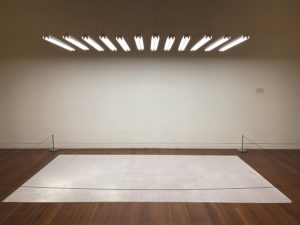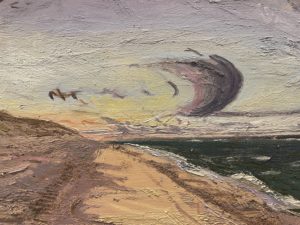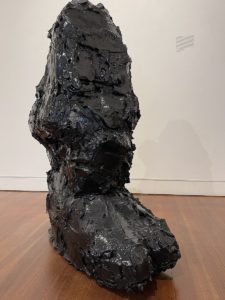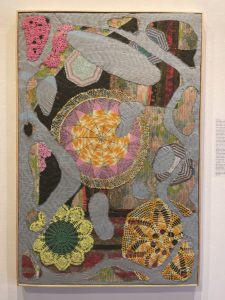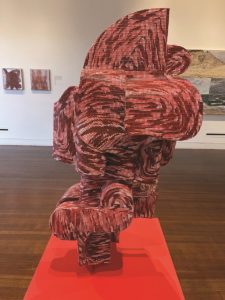Tom Pappas is what some call a “painter’s painter” — one immersed in paint’s possibilities, letting process determine the result. For Pappas, the results are modest-size abstractions with earthy colors and excavated surfaces.

This is the 63-year-old artist’s second stint as a visual fellow at the Fine Arts Work Center. The first was in 1991, right after Pappas graduated with an M.F.A. in painting from the Mass. College of Art and Design. Pappas spent the last eight years living in Brooklyn, N.Y. with his partner, the painter Sharon Horvath.
Both of Pappas’s parents were art professors. Despite an initial lack of interest in the artistic life, “Gradually it sucked me in,” he admits. Born in Pennsylvania, Pappas grew up in Miami, Fla., attending high school in Tampa and getting a B.F.A. from the University of South Florida before moving to Boston. His story is one of moving around and extensive travel that eventually took him to California on a cooking scholarship at a Zen monastery in the San Jacinto Mountains.
“I’d always been interested in Zen Buddhism,” he says. “I had gone to a monastery in the Catskills when I was 18 for six months.” He stayed in California for five years. “It was challenging but it was great. It was an opportunity to live in a really interesting community and think a lot about painting.
“I had a little studio there. I decided that I was going to be an abstract painter, just a purely rational decision after meditating a lot,” he says. “I thought it was something that would sustain me going onward.
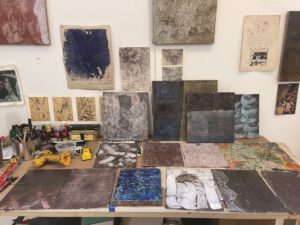
“My paintings go in different directions,” continues Pappas. “Some are landscapes, some are more figurative. It’s been a long-term goal to not think about whether I’m doing an abstract painting or a figurative one, to just follow the process and personality of the individual canvas.” It’s an approach, he says, not dissimilar to meditation.
“I painted for a long time thinking that I would hit on some subject matter or particular technique that I would then go on using, but it never happened,” he says. “I’m more interested in what’s going on in my mind, that there can be shifts that are then expressed on the canvas.” The paintings become physical manifestations of psychological and emotional states.
“That happens unintentionally,” he says. “I’m just looking for something surprising or new to me.” A painting of a red winged form, for example, emerges mysteriously from the ether. His work is largely untitled.
Some paintings require a jump start. That’s when Pappas will employ graphic stencils of shapes, letters, and numbers, or “improvisational brushwork and drawing right on the canvas, trying to stir up the ground to reveal an image.” Using open, loose strokes, Pappas enjoys “going back and forth between white and color,” a technique he compares to “the way clouds move and suggest images.
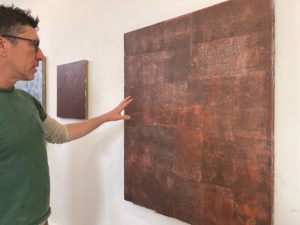
“There’s an erosion that happens as I’m putting on and taking off paint,” says Pappas. The final part of his process involves “polishing off the paint until it gets to the point where everything’s come off that’s going to come off and the painting is just there.”
Pappas’s palette is influenced by ancient art: red from Mayan ceramics and tones derived from the Earth. “I like the mineral quality, when it sort of looks like you’re looking at a rock,” he says.
Pappas worked for six years as a security guard at the Museum of Fine Arts, Boston and at Harvard’s Fogg Art Museum. “That was the best education I could ever have, in terms of really staring at paintings for hours and noticing what held my attention. One of the things was surface, especially ancient, patinated surfaces.”
Pappas has spent a lot of time thinking about cave painting. “I imagine that looking at the wall of a cave would be so suggestive, especially if there are flames flickering,” he says. “You’d see images that then could become a painting. I have this strong sense that’s how a lot of those beautiful images came about. It’s just so suggestive, that irregular surface.
“I would like to make that kind of painting, one with a timeless quality,” continues Pappas. “In some ways, I think I’m more like a cave painter.”
Painting Rocks
